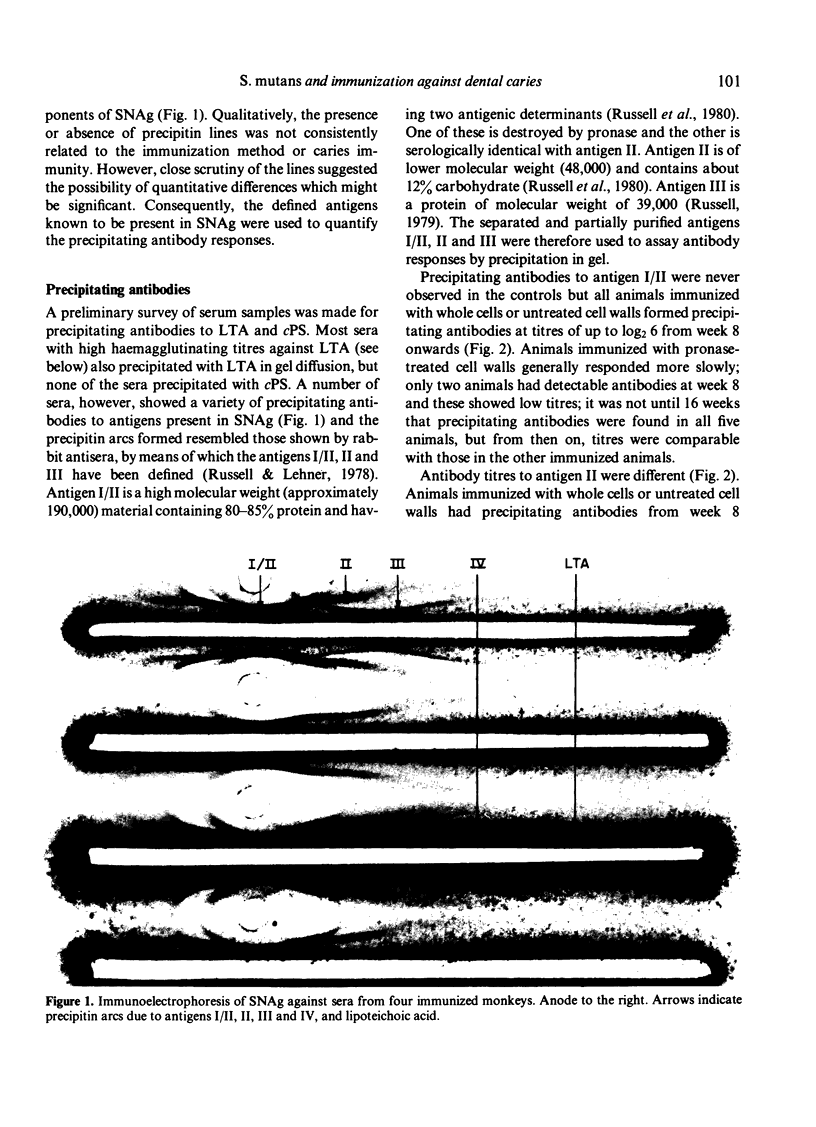Abstract
Protection against smooth surface dental caries was investigated in fifteen young rhesus monkeys which were immunized subcutaneously with Streptococcus mutans serotype c in Freund's incomplete adjuvant. Monkeys immunized with killed whole organisms developed significantly less caries than control animals. Monkeys immunized with pronase-treated cell walls developed significantly more caries than control animals while monkeys immunized with untreated cell walls showed no such enhancement of caries. Haemagglutinating and complement-fixing antibodies to cell walls and culture supernatant antigens (SN Ag) of S. mutans developed in the sera of all immunized animals to a similar degree. Antibodies to lipoteichoic acid and to an insoluble dextran preparation were found in all immunized animals and showed no relationship to the prevalence of caries. Antibodies to the serotype c polysaccharide were also found in animals immunized with whole cells and pronase-treated cell walls. However, precipitating antibody levels to partially purified antigens I/II and II, derived from SN Ag, but present also in cells, were related to the development of caries. Animals immunized with whole cells and with untreated cell walls developed a brisk antibody response to antigen I/II, while those immunized with pronase-treated cell walls responded more slowly. The results suggest that immunization may induce both caries reduction and enhancement, depending on the antibody response which is developed.
Full text
PDF









Images in this article
Selected References
These references are in PubMed. This may not be the complete list of references from this article.
- Bleiweis A. S., Taylor M. C., Deepak J., Brown T. A., Wetherell J. R., Jr Comparative chemical compositions of cell walls of Streptococcus mutans. J Dent Res. 1976 Jan;55:A103–A108. doi: 10.1177/002203457605500102011. [DOI] [PubMed] [Google Scholar]
- Bowen W. H., Cohen B., Cole M. F., Colman G. Immunization against dental caries. Br Dent J. 1975 Jul 15;139(2):45–58. [PubMed] [Google Scholar]
- Challacombe S. J., Russell M. W., Hawkes J. Passage of intact IgG from plasma to the oral cavity via crevicular fluid. Clin Exp Immunol. 1978 Dec;34(3):417–422. [PMC free article] [PubMed] [Google Scholar]
- Genco R. J., Evans R. T., Taubman M. A. Specificity of antibodies to Streptococcus mutans; significance in inhibition of adherence. Adv Exp Med Biol. 1974;45(0):327–336. doi: 10.1007/978-1-4613-4550-3_39. [DOI] [PubMed] [Google Scholar]
- Hardie J. M., Bowden G. H. Cell wall and serological studies on Streptococcus mutans. Caries Res. 1974;8(4):301–316. doi: 10.1159/000260120. [DOI] [PubMed] [Google Scholar]
- Hämmerling U., Westphal O. Synthesis and use of O-stearoyl polysaccharides in passive hemagglutination and hemolysis. Eur J Biochem. 1967 Mar;1(1):46–50. doi: 10.1007/978-3-662-25813-2_9. [DOI] [PubMed] [Google Scholar]
- Knox K. W., Wicken A. J. Immunological properties of teichoic acids. Bacteriol Rev. 1973 Jun;37(2):215–257. doi: 10.1128/br.37.2.215-257.1973. [DOI] [PMC free article] [PubMed] [Google Scholar]
- Lehner T., Challacombe S. J., Caldwell J. An experimental model for immunological studies of dental caries in the rhesus monkey. Arch Oral Biol. 1975 May-Jun;20(5-6):299–304. doi: 10.1016/0003-9969(75)90018-7. [DOI] [PubMed] [Google Scholar]
- Lehner T., Challacombe S. J., Caldwell J. An immunological investigation into the prevention of caries in deciduous teeth of rhesus monkeys. Arch Oral Biol. 1975 May-Jun;20(5-6):305–310. doi: 10.1016/0003-9969(75)90019-9. [DOI] [PubMed] [Google Scholar]
- Linzer R., Gill K., Slade H. D. Chemical composition of Streptococcus mutans type c antigen: comparison to type a, b, and d antigens. J Dent Res. 1976 Jan;55:A109–A115. doi: 10.1177/002203457605500103011. [DOI] [PubMed] [Google Scholar]
- Markham J. L., Knox K. W., Wicken A. J., Hewett M. J. Formation of extracellular lipoteichoic acid by oral streptococci and lactobacilli. Infect Immun. 1975 Aug;12(2):378–386. doi: 10.1128/iai.12.2.378-386.1975. [DOI] [PMC free article] [PubMed] [Google Scholar]
- Melvaer K. L., Helgeland K., Rölla G. A charged component in purified polysaccharide preparations from Streptococcus mutans and Streptococcus sanguis. Arch Oral Biol. 1974 Jul;19(7):589–595. doi: 10.1016/0003-9969(74)90077-6. [DOI] [PubMed] [Google Scholar]
- Mukasa H., Slade H. D. Mechanism of adherence of Streptococcus mutans to smooth surfaces. II. Nature of the binding site and the adsorption of dextran-levan synthetase enzymes on the cell-wall surface of the streptococcus. Infect Immun. 1974 Feb;9(2):419–429. doi: 10.1128/iai.9.2.419-429.1974. [DOI] [PMC free article] [PubMed] [Google Scholar]
- Russell M. W., Challacombe S. J., Lehner T. Serum glucosyltransferase-inhibiting antibodies and dental caries in rhesus monkeys immunized against Streptococcus mutans. Immunology. 1976 May;30(5):619–627. [PMC free article] [PubMed] [Google Scholar]
- Russell M. W. Purification and properties of a protein surface antigen of Streptococcus mutants. Microbios. 1979;25(99):7–18. [PubMed] [Google Scholar]
- Taubman M. A., Smith D. J. Effects of local immunization with glucosyltransferase fractions from Streptococcus mutans on dental caries in rats and hamsters. J Immunol. 1977 Feb;118(2):710–720. [PubMed] [Google Scholar]
- Wetherell J. R., Jr, Bleiweis A. S. Antigens of Streptococcus mutans: characterization of a polysaccharide antigen from walls of strain GS-5. Infect Immun. 1975 Dec;12(6):1341–1348. doi: 10.1128/iai.12.6.1341-1348.1975. [DOI] [PMC free article] [PubMed] [Google Scholar]
- Wicken A. J., Gibbens J. W., Knox K. W. Comparative studies on the isolation of membrane lipoteichoic acid from Lactobacillus fermenti. J Bacteriol. 1973 Jan;113(1):365–372. doi: 10.1128/jb.113.1.365-372.1973. [DOI] [PMC free article] [PubMed] [Google Scholar]



